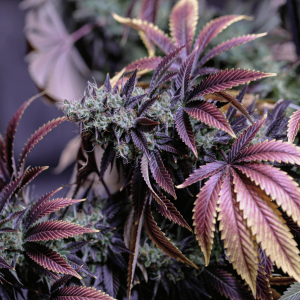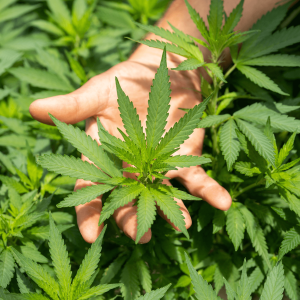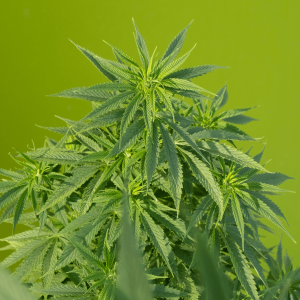Here’s something you didn’t learn in high school science class: Cannabis Plant Anatomy.
That’s right, stoners… today we’re breaking down the cannabis plant to discuss a fascinating topic that we only wish was covered during 12th-grade science. Maybe then we would have paid attention? Anyways…
Welcome to our amazing guide on the anatomy of a cannabis plant, a true wonder of nature that has captivated enthusiasts and growers alike! Whether you’re an experienced grower or simply curious, exploring the anatomy of the cannabis plant is essential to fully appreciating its potential and fascinating intricacies.
In this blog, we’ll dive into the intricate structure of the cannabis plant, uncover its unique characteristics, and shed light on why this knowledge is crucial for cannabis enthusiasts and cultivators alike. Let’s get started!
The Basics of Cannabis Plant Structure
Just like other plants, cannabis plants are made up of several key components, each playing a crucial role in its life cycle.
Let’s dive into an overview of these main parts and their distinct functions, shall we?
Overview of the plant’s main parts
- Roots: The roots of the cannabis plant serve as its lifeline, absorbing water and essential nutrients from the soil. Additionally, they anchor the plant in place and provide the stability it requires to grow.
- Stem: The stem acts as the plant’s transportation system, carrying water, nutrients, and sugars between the roots and other parts of the plant. It also gives the plant its structure, allowing it to reach towards the sunlight for photosynthesis.
- Leaves: The leaves are the solar panels of the cannabis plant. They capture sunlight and convert it into energy through the process of photosynthesis. Now that’s a term we recognize from high school.
Functions of each part in the plant’s life cycle.
- Roots Function: The cannabis roots not only anchor the cannabis plant into the ground but also absorb the necessary nutrients and water from the soil. This absorption sustains the plant’s growth and development throughout its life cycle.
- Stem Function: The stem’s role is vital in transporting these nutrients and water from the roots to the rest of the plant. It also supports the plant, enabling it to grow upwards and reach the sunlight, which is essential for photosynthesis.
- Leaves Function: The leaves play a critical role in photosynthesis, the process by which the plant converts sunlight, carbon dioxide, and water into glucose. This glucose provides the energy the cannabis plant needs to grow and develop.
Cannabis Flower Structure
The flower of the cannabis plant is arguably its most visually appealing and biologically significant component. It’s here where the magic happens, with the flowering phase marking the plant’s transition from vegetative growth to a period of robust cannabinoid production.
Detailed Breakdown of the Flower Components
Let’s expand on the primary components of the marijuana flower:
- Calyx and Pistils: The calyx is the first part of the flower that forms. Think of it as a protective layer housing the developing flower. The calyx is covered in resinous trichomes and contains the pistils, which are tiny hair-like structures. The pistils are crucial for reproduction. They start off white and slowly turn to a reddish-brown as the plant matures.
- Trichomes and Resin Glands: Now we get to the good stuff. Trichomes are the tiny crystals that cover the buds and leaves of the cannabis plant. They are responsible for producing the resin that contains the cannabinoids (like THC and CBD), terpenes, and flavonoids. The more trichomes a cannabis bud has, the more potent it is likely to be.

Importance of Flowers in the Cannabis Life Cycle
Flowers are incredibly important in the life cycle of the cannabis plant. During the flowering stage, the plant shifts its energy from the vegetative growth process to the production of flowers.
These flowers house the trichomes, which are the plant’s cannabinoid factories. The cannabinoids are what give cannabis its therapeutic and psychoactive properties.
Understanding the cannabis flower’s structure and functions can help growers optimize their cultivation practices and users appreciate the complexity of this remarkable plant.

Understanding Cannabis Genetics
Diving deeper into the world of cannabis, we must acknowledge an essential aspect that often goes overlooked – Cannabis Genetics.
Genetics play a monumental role in determining the characteristics of a cannabis plant, from its growth pattern and resistance to diseases to its cannabinoid content and flavor profile. The blueprint of a cannabis plant is inherently encoded in its DNA, guiding its development and eventual output.
For cultivators, understanding a strain’s genetics can aid in predicting growth patterns and optimizing cultivation practices. On the flip side, for consumers, genetics influence the psychoactive and therapeutic effects of the cannabis strains they consume, thus playing an instrumental role in the overall cannabis experience.
Unraveling cannabis genetics illuminates the complexities behind this diverse plant species and its numerous strains, providing valuable insights for both cultivators and consumers.
Leaf Variations and Identification
Cannabis leaves are an integral part of the plant’s identity. Not only do they play a crucial role in photosynthesis, but their shape, size, and color also provide valuable clues about the plant’s genetic background.
By studying these leaf variations, we can enhance our ability to identify different cannabis strains.
Examination of Different Cannabis Leaf Types
Cannabis leaves can be broadly classified under two categories: Sativa and Indica, with each having distinct characteristics that set them apart.
Sativa vs. Indica Leaves
Sativa leaves are typically long and narrow, with slender fingers and a lighter shade of green. On the other hand, indica leaves are broader, darker in color, and have stout fingers. The difference in their leaf structure is a reflection of their contrasting growth habits and native climates.
Hybrid Leaf Characteristics
As the name suggests, hybrids are a genetic mix of sativa and indica strains, and their leaves display traits from both parents. The characteristics can vary widely based on the plant’s specific genetic lineage, but generally, a hybrid leaf will fall somewhere between the broad indica leaf and the slender sativa leaf in terms of size and shape.
How Leaf Variations Influence Strain Identification
The diverse cannabis leaf structures play a crucial role in strain identification.
By observing the unique physical characteristics of the leaves, we can gain valuable insights into the genetic makeup of the plant. For instance, a plant with broad, dark green leaves is likely an indica strain, while one with long, slender leaves would be a sativa strain.
Hybrid leaves, with their variable traits, can be trickier to identify. However, their characteristics will still provide clues to their lineage. A hybrid with leaves that lean more toward the sativa end of the spectrum would likely produce effects associated with sativa strains, and vice versa.
Understanding and identifying leaf variations can be a powerful tool for growers and enthusiasts alike, allowing them to predict the plant’s growth patterns, resistance to diseases, and potential psychoactive effects.

The Role of Cannabinoids and Terpenes
Cannabinoids and terpenes are key chemical compounds that define the cannabis plant’s unique properties and various uses.
Cannabinoids, including popular ones like THC (Tetrahydrocannabinol) and CBD (Cannabidiol), are primarily responsible for the plant’s psychoactive and therapeutic effects. They interact with the body’s endocannabinoid system, influencing a range of physiological processes, from mood to pain perception.
Terpenes, on the other hand, are aromatic compounds found in many plants, including cannabis. They give cannabis strains their distinctive scents and flavors, from the earthy aroma of Kush strains to the citrusy tang of Lemon Haze.
More than just scent-makers, terpenes also contribute to the plant’s therapeutic effects through a phenomenon known as the entourage effect.
Production and Storage of Cannabinoids and Terpenes
Cannabinoids are produced in the cannabis plant’s resinous trichomes, specifically within the resin glands. They start as cannabinoid acids that convert to active cannabinoids through a process known as decarboxylation, commonly occurring when the plant matter is heated during smoking or cooking.
Similarly, terpenes are produced and stored within the same trichomes, lending their aroma to the resin.
Understanding the interplay of cannabinoids and terpenes not only enhances appreciation for the cannabis plant but can also inform consumer choices and cultivation strategies for growers.
Growth Stages of the Cannabis Plant
Understanding the life cycle of the cannabis plant is crucial for both growers and stoners alike. After all, it allows growers to optimize their cultivation practices and stoners to appreciate the process that leads to the final product.
Below, we dive into the four primary stages of the cannabis plant’s growth cycle.
Germination and Seedling Stages
As with any plant, the journey of a cannabis plant begins with germination. This stage typically lasts between 24 hours to a week. It involves the sprouting of cannabis seeds, which occurs in a warm, moist environment.
Following successful germination, the plant enters the seedling stage. This stage is characterized by a rapid growth of leaves and roots. It’s important to keep in mind that seedlings are delicate and require careful attention to temperature, light exposure, and moisture to thrive.
Vegetative Growth
Next is the vegetative growth stage, the phase in which the plant develops its main stem and structure.
During this stage, the plant focuses on growing taller and producing a robust branching and vascular system to support future flowers. Leaves and branches grow rapidly, and the plant requires plenty of light, nutrients, and water.
This stage can last from a few weeks to several months, depending on the plant’s genetics and environmental conditions.
Flowering Stage
The flowering stage is when the magic happens. After receiving signals from environmental cues — usually changes in light exposure — the plant shifts its energy towards producing flowers, fan leaves, sugar leaves, pollen sacs, or cannabis buds.
This is also the stage where cannabis plants exhibit the plant’s sex. Female cannabis plants produce cannabinoid-rich flowers, while male marijuana plants produce pollen sacs, which are the male sex organs that collect pollen. The flowering stage typically lasts between 6 to 10 weeks for most strains.
Harvesting and Post-Harvest Stages
After the flowering stage comes the harvest. Timing the harvest correctly is crucial to ensure optimal potency and quality of the female plant buds.
Following the harvest, the female cannabis plants enter the post-harvest stages, which include drying and curing. These stages are pivotal in preserving the flavor and quality of the female cannabis plant, as well as in maximizing its shelf life.
Proper curing can significantly elevate the overall quality and experience of the final product.
Understanding these growth stages guides cannabis cultivators in optimizing their practices, resulting in healthier cannabis plants and a high-quality yield. For cannabis consumers, it provides an appreciation of the complex process that leads to the creation of the cannabis products we all know and love.

Environmental Factors Affecting Cannabis Anatomy
The anatomy of the cannabis plant is greatly influenced by various environmental conditions such as light, temperature, humidity, and nutrient availability.
Light, especially its intensity and duration, plays a pivotal role in the cannabis plant’s growth and development. It drives photosynthesis, a crucial process for the plant’s survival and production of cannabinoids and terpenes.
Ideal temperature ranges are also critical to maintain, as too cold or too warm temperatures can stunt growth or trigger stress responses in the plant.
Relative humidity needs to be carefully managed as well. Excess humidity can create a breeding ground for mold and other pathogens, while low humidity levels can lead to slowed growth and transpiration issues.
Nutrient Requirements for Optimal Plant Development
Nutrient requirements, too, play an essential part in the cannabis plant’s development. Like all plants, cannabis plants require a range of macro and micronutrients for optimal growth.
Macronutrients, including Nitrogen (N), Phosphorous (P), and Potassium (K), have a big impact on growth, flowering, and overall plant health. Micronutrients, though required in smaller quantities, are equally important, aiding in various biochemical processes.
An imbalanced nutrient regimen can lead to deficiencies or toxicities, potentially jeopardizing the plant’s health and yield. By understanding these environmental factors, growers can create an optimal environment for cannabis plants to thrive, maximizing their growth potential and the quality of their yield.

Cannabis Anatomy and Consumption
The structure of the cannabis plant significantly influences the potency and effect of the products derived from it.
The potency of cannabis largely depends on the concentration of cannabinoids and terpenes within the plant, which are primarily produced and stored in the resinous trichomes found on the flowers of the plant. Thus, flowers are often the most potent part parts of the cannabis plant and are commonly consumed for their high cannabinoid content.
On the flip side, the leaves of the cannabis plant contain fewer trichomes and, therefore, lower concentrations of cannabinoids and terpenes. However, they are still used in the creation of extracts and edibles where they are heated or decarboxylated to convert the cannabinoid acids into active cannabinoids.
Cannabis extracts, on the other hand, are concentrated preparations that capture the plant’s potent compounds, delivering a more amplified effect compared to the raw plant material. These extracts can be derived from both the flowers and leaves, and offer a more potent, condensed form of cannabis, providing a heightened experience to the consumer.
Understanding these differences in cannabis anatomy and the resulting potency in different forms of consumption can guide consumers in their selection of cannabis products to meet their individual needs and preferences.
Conclusion
In closing, the intricacies associated with marijuana plant anatomy play a significant role in the quality and potency of your favorite cannabis products.
From germination to harvesting, the plant undergoes distinct developmental stages, each crucial in shaping the final product’s properties. Environmental factors, including light, temperature, humidity, and nutrient availability, also greatly influence the plant’s growth and development.
The plant’s structure itself, particularly its cannabinoid and terpene-rich trichomes, is paramount in determining the potency of the consumed products. Whether it’s flowers rich in resinous trichomes or leaves and extracts used for their cannabinoid content, every part of the cannabis plant contributes to the diverse range of cannabis products we see today.
Understanding the complexities of the weed plant not only enhances our ability to cultivate and consume cannabis effectively but also deepens our appreciation for this incredibly versatile plant.
Frequently Asked Questions
1. What is the role of trichomes in the cannabis plant’s anatomy?
Trichomes are small, resinous glands that appear on the flowers and leaves of cannabis plants. They play a vital role in the plant’s survival and potency as they produce and store cannabinoids and terpenes, the compounds responsible for the plant’s medicinal properties and unique aroma.
2. Why are environmental factors like light, temperature, humidity, and nutrient availability important for the growth and development of the cannabis plant?
Environmental factors greatly influence the cannabis plant’s growth, development, and overall health. Light drives photosynthesis, aiding in the production of cannabinoids and terpenes. Temperature affects the metabolism and growth rate of the marijuana plant. Humidity levels can influence the plant’s susceptibility to mold and other pathogens. Nutrient availability ensures optimal growth and development, with imbalances potentially leading to deficiencies or toxicities.
3. Why is the flowering stage significant in the anatomy of the cannabis plant?
The flowering stage is when cannabis plants reveal their sex and female cannabis plants produce cannabinoid-rich flowers. This stage is crucial as the timing of the harvest, which follows the flowering stage, impacts the optimal potency and quality of the buds. The duration of the flowering stage can last between 6 to 10 weeks depending on the strain.

 Rewards
Rewards




